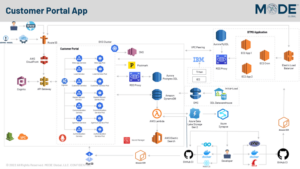Get to know our client.
MODE Global, is a leading player in the Transport Management Logistics and Systems (TMS) industry. Their services span across truckload, intermodal, LTL, ocean, drayage, air, parcel, less-than-truckload, and everything in between.
Continue Reading
Challenges – Seeking a standalone customer portal application.
The client sought to develop a standalone customer portal application to efficiently book carriers and get the price quote details, as their legacy TMS portal was inefficient.
They had unique business requirements and challenges with their existing systems in play.
Persona-specific customer portal – Headless/UI application
The client aimed to serve three different front-end applications, each tailored to a specific user group such as agents, end users, and partners. Also, they wanted to build headless (API) and UI-based interfaces, so that the partners can seamlessly integrate these APIs in their applications. This API integration enables their end users to book carrier slots and get standard price quote details from MODE global TMS application.
Tightly coupled monolithic application architecture
The legacy customer portal was built on a monolithic architecture that was tightly coupled with other Transport Management Systems (TMS). This elevated the complexities of making changes or updates to the customer portal without affecting the entire system. Also, the traditional architecture hindered their ability to independently scale, innovate, and optimize specific components.
Container orchestration complexity
The legacy customer portal was deployed in a Docker container on AWS EC2 using Docker Compose. However, this setup lacked a well-defined container orchestration layer, making it difficult to manage containerized services efficiently. As a result, autoscaling and load balancing were cumbersome, leading to operational complexities.
Frequent deployments and high downtime
The legacy application architecture pivoted to frequent deployments, changes, and updates. These deployments resulted in prolonged downtime, adversely affecting application availability and overall user experience.
Solution – Reengineering the customer portal application with modular & lightweight architecture.
Our team devised a comprehensive application and infrastructure modernization strategy, considering the client’s unique business challenges and organizational model.

Monolithic – Microservices architecture
We recommended transforming their monolithic application into a microservices-based architecture. This approach enabled the development of independent, modular services, offering greater flexibility, scalability, and ease of maintenance.
Kubernetes implementation (AWS EKS)
Our cloud team implemented Kubernetes (K8s) for the container orchestration of microservices. With AWS Elastic Kubernetes Service (EKS), we built a robust orchestration layer, that delivers auto scalability, efficient resource utilization, and high application availability.
GitOps & Flux CD
To streamline the application deployment process, our DevOps experts implemented GitOps using GitHub as a single source of truth. Further, we facilitated automated K8s deployment using Flux CD, ensuring consistency and reliability of the application.
Global Customer Database (GCDB)
To streamline the application deployment process, our DevOps experts implemented GitOps using GitHub as a single source of truth. Further, we facilitated automated K8s deployment using Flux CD, ensuring consistency and reliability of the application.
Infrastructure-as-a-code (IAC)
We delivered Terraform templates for Infrastructure as a code (IAC) deployment to the client’s application management team. This approach enabled consistent and reproducible infrastructure provisioning, without any human intervention.
Enhanced security & observability
On top of the customer portal, we implemented robust security practices leveraging AWS services like RDS proxy, Secret Manager, Cognito, and Certificate Manager to protect the sensitive PII data of customers & prevent security breaches. We employed AWS CloudWatch to log and monitor the application metrics 24/7 with multi-level email alerts on anomalies.
Benefits – 46% reduction in operational overhead
Enhanced user experience
The microservices architecture and responsive design ensured an engaging experience for diverse user groups, enhancing user satisfaction and engagement.
Cost optimization
The cloud-native approach allowed the client to optimize costs through on-demand scaling, ensuring optimal resource utilization.
Scalability & flexibility
AWS EKS-based container orchestration allowed for effortless scaling, enabling the application to adapt to varying workloads without compromising performance.
Faster time to market with DevOps pipeline
GitOps & Flux CD reduced deployment downtime and enhanced application availability, improving operational efficiency.
Adhering to security & compliances
The robust security measures and compliance standards safeguarded customer data and reinforced user trust in the application.
Tech Stack
- AWS EKS
- AWS ECR
- ALB(Application load balancer)
- AWS SNS
- AWS SQS
- AWS SQS
- AWS RDS
- AWS RDS Proxy
- Secret Manager
- API Gateway
- S3
- AWS Certificate Manager
- GitHub
- AWS S2S VPN
- AWS CloudWatch
- Route 53
- AWS Cognito
- AWS CloudFront
- AWS Elastic search
- AWS Dynamo DB
- AWS DMS
- AWS Pinpoint
Ready to modernize your application architecture?
Our partnership with MODE revolutionized its capabilities and provided a future-ready customer portal application. They gained significant business benefits that positioned the organization for future growth and innovation. This cloud transformation demonstrates the power of cloud-native solutions in driving business success and customer satisfaction in the logistics industry.
Do you strive to modernize your legacy application infrastructure? What are you waiting for?